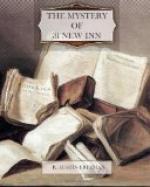“I should say very decidedly not,” said Mr. Britton, “if I understood Marchmont aright. And, even if there were, let me tell you, these signatures that you have got wouldn’t help you. I have looked them over very closely—and I have seen a few signatures in my time, you know. Marchmont asked me to glance over them as a matter of form, but I don’t believe in matters of form; I examined them very carefully. There is an appreciable amount of variation; a very appreciable amount. But under the variation one can trace the personal character (which is what matters); the subtle, indescribable quality that makes it recognizable to the expert eye as Jeffrey Blackmore’s writing. You understand me. There is such a quality, which remains when the coarser characteristics vary; just as a man may grow old, or fat, or bald, or may take to drink, and become quite changed; and yet, through it all, he preserves a certain something which makes him recognizable as a member of a particular family. Well, I find that quality in all those signatures, and so will you, if you have had enough experience of handwriting. I thought it best to mention it in case you might be giving yourself unnecessary trouble.”
“It is very good of you,” said Thorndyke, “and I need not say that the information is of great value, coming from such a highly expert source. As a matter of fact, your hint will be of great value to me.”
He shook hands with Mr. Britton, and, as the latter disappeared down the stairs, he turned into the sitting-room and remarked:
“There is a very weighty and significant observation, Jervis. I advise you to consider it attentively in all its bearings.”
“You mean the fact that these signatures are undoubtedly genuine?”
“I meant, rather, the very interesting general truth that is contained in Britton’s statement; that physiognomy is not a mere matter of facial character. A man carries his personal trademark, not in his face only, but in his nervous system and muscles—giving rise to characteristic movements and gait; in his larynx—producing an individual voice; and even in his mouth, as shown by individual peculiarities of speech and accent. And the individual nervous system, by means of these characteristic movements, transfers its peculiarities to inanimate objects that are the products of such movements; as we see in pictures, in carving, in musical execution and in handwriting. No one has ever painted quite like Reynolds or Romney; no one has ever played exactly like Liszt or Paganini; the pictures or the sounds produced by them, were, so to speak, an extension of the physiognomy of the artist. And so with handwriting. A particular specimen is the product of a particular set of motor centres in an individual brain.”
“These are very interesting considerations, Thorndyke,” I remarked; “but I don’t quite see their present application. Do you mean them to bear in any special way on the Blackmore case?”




